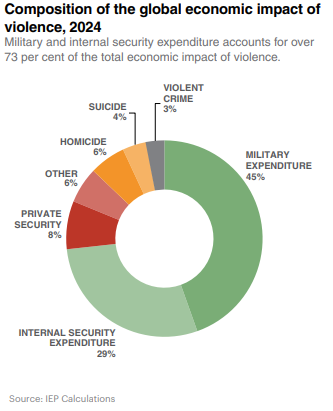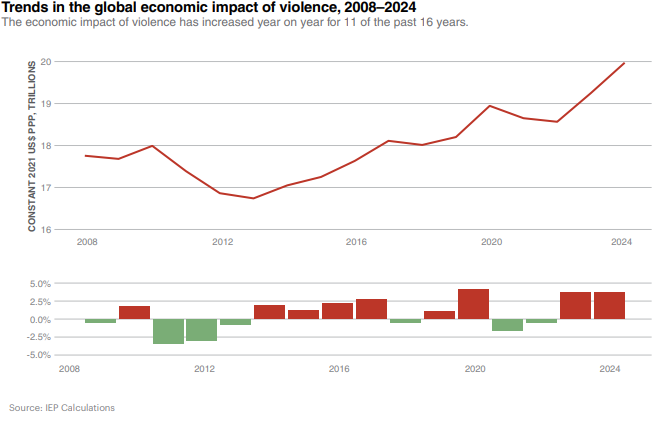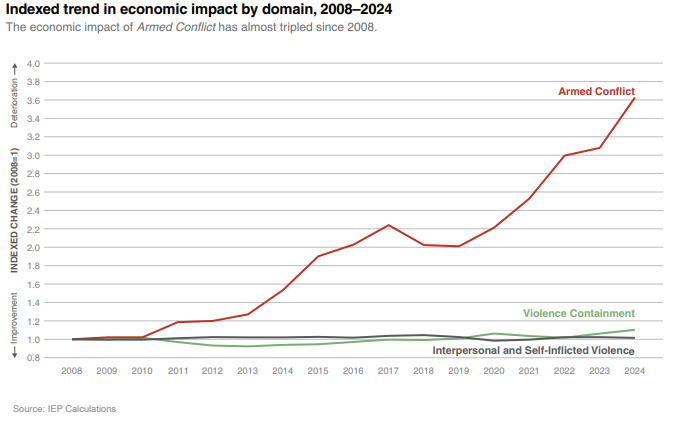The global economic impact of violence is defined as the expenditure and economic effect related to containing, preventing and dealing with the consequences of violence. Understanding the economic impact of violence provides a basis for calculating the economic benefits resulting from
improvements in peace.
Violence and the fear of violence create significant economic disruptions. Violent incidents generate costs in the form of property damage, physical injury, and psychological trauma. Fear of violence also alters economic behaviour, primarily by reducing the propensity to invest and consume. Expenditure on preventing, containing, and dealing with the consequences of violence diverts public and private resources away from more productive activities and towards protective measures. Violence generates economic losses in the form of productivity shortfalls, foregone earnings, and distorted expenditure.
The total economic impact of violence has three components that represent different ways in which violence impacts economic activity: direct costs, indirect costs and a multiplier effect.
In 2024, the impact of violence on the global economy amounted to $19.97 trillion in purchasing power parity (PPP) terms. This is equivalent to 11.6 per cent of global GDP, or $2,455 per person. The total economic impact of violence increased by 3.8 per cent over the past year owing largely to an increase in GDP losses from conflict, as well as increases in military expenditure.
The chart below displays the breakdown of the total economic impact of violence by 15 categories for 2024.

In real terms, the overall impact of violence was 12.8 per cent higher in 2024 than in 2008. Substantial improvements were recorded between 2010 and 2013, after which the impact has steadily risen. Since 2008, 100 countries have recorded deteriorations in their economic impact of violence, while 61 have improved. The average deterioration was 21.9 per cent, while the average improvement was 52.4 per cent.

The 15 categories of the economic impact of violence can be grouped into three domains: Armed Conflict, Interpersonal and Self-Inflicted Violence, and Violence Containment. The relative long-term trends in the economic impact of violence differ significantly across these three domains. The chart below shows the indexed change in the three domains since 2008. The Armed Conflict domain has increased substantially since 2013, while Violence Containment and Interpersonal and Self-Inflicted Violence have recorded relatively small changes.

There are noticeable regional differences in the economic impact of violence. In some regions, the Violence Containment domain, and in particular military expenditure, accounts for most of the economic impact, while in other regions crime and conflict are the largest components of the economic impact of violence.
The economic impact of violence deteriorated for six regions of the world in 2024 and improved in two as shown in Figure 3.8. Eastern Europe and Central Asia had the largest deterioration, at 37 per cent. This is mostly due to increased impact in Russia, Ukraine, Kazakhstan and Azerbaijan. In Russia, this deterioration can be attributed to an increase in military expenditure, conflict deaths from Ukraine’s incursion into the Kursk region, and the increasing impact of terrorism. The increase in Azerbaijan was driven by increased military expenditure due to increased weapons imports.

This analysis is based on the Economic Impact of Violence findings from the Global Peace Index 2025.